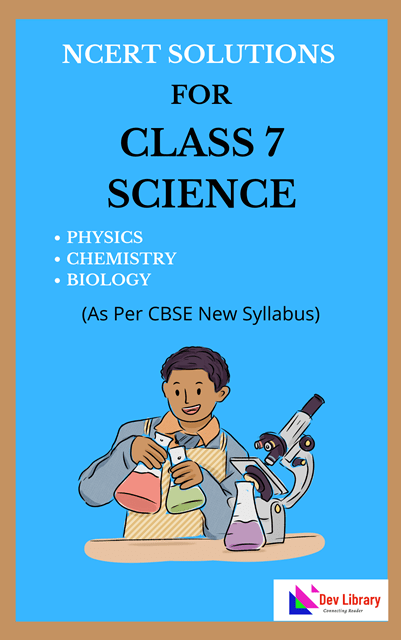NCERT Class 7 Science Chapter 4 The World of Metals and Non-metals Solutions to each chapter is provided in the list so that you can easily browse through different chapters NCERT Class 7 Science Chapter 4 The World of Metals and Non-metals and select need one. NCERT Class 7 Science Chapter 4 The World of Metals and Non-metals Question Answers Download PDF. NCERT Class 7 Science Solutions.
NCERT Class 7 Science Chapter 4 The World of Metals and Non-metals
Also, you can read the NCERT book online in these sections Solutions by Expert Teachers as per Central Board of Secondary Education (CBSE) Book guidelines. CBSE Class 7 Science Solutions are part of All Subject Solutions. Here we have given NCERT Class 7 Science Solutions and Textbook for All Chapters, You can practice these here.
The World of Metals and Non-metals
Chapter: 4
Page No – 43
Table 4.1: Appearance, hardness, and effect of hammering on different objects or materials.
| S.No. | Object/Material | Appearance (lustrous/ non-lustrous) | Hard/Soft | Effect of hammering (flattens/breaks into pieces) |
| 1 | Piece of copper | |||
| 2 | Piece of aluminium | |||
| 3 | Iron nail | |||
| 4 | Piece of coal | |||
| 5 | Lump of sulfur (pea-sized) | |||
| 6 | Block of wood |
Ans:
| S.No. | Object/Material | Appearance (lustrous/ non-lustrous) | Hard/Soft | Effect of hammering (flattens/breaks into pieces) |
| 1 | Piece of copper | Lustrous | Hard | Flattens |
| 2 | Piece of aluminium | Lustrous | Hard | Flattens |
| 3 | Iron nail | Lustrous | Hard | Flattens |
| 4 | Piece of coal | Non-lustrous | Hard | Breaks into pieces |
| 5 | Lump of sulfur (pea-sized) | Non-lustrous | Soft | Breaks into pieces |
| 6 | Block of wood | Non-lustrous | Hard | Breaks into pieces |
Page No : 48
Table 4.2: Conduction of electricity by different objects or materials.
| S.No | Object/Material | Observation (bulb glows/does not glow) | Good conductor of electricity or poor conductor of electricity |
| 1 | Piece of aluminium foil | ||
| 2 | Iron nail | ||
| 3 | Lump of sulfur (pea-sized) | ||
| 4 | … |
Ans:
| S.No | Object/Material | Observation (bulb glows/does not glow) | Good conductor of electricity or poor conductor of electricity |
| 1 | Piece of aluminium foil | bulb glows | Good conductor |
| 2 | Iron nail | bulb glows | Good conductor |
| 3 | Lump of sulfur (pea-sized) | bulb does not glows | poor conductor |
| 4 | Plastic | bulb does not glows | poor conductor |
Page No – 49
Table 4.3: Formation of brown deposit on iron nails
| Conditions | |||
| Glass Bottle | Presence of water (Yes/No) | Presence of air (Yes/No) | Observations |
| A | No | Yes | |
| B | |||
| C | |||
Ans:
| Conditions | |||
| Glass Bottle | Presence of water (Yes/No) | Presence of air (Yes/No) | Observations |
| A | No | Yes | No brown deposit formed |
| B | Yes | No | No brown deposit formed |
| C | Yes | Yes | Brown deposit formed |
| Let Us Enhance Our Learning |
1. Which metal is commonly used to make food packaging materials as it is cheaper, and its thin sheets can be folded easily into any shape?
(i) Aluminium.
(ii) Copper.
(iii) Iron.
(iv) Gold.
Ans: (i) Aluminium.
2. Which of the following metal catches fire when it comes in contact with water?
(i) Copper.
(ii) Aluminium.
(iii) Zinc.
(iv) Sodium.
Ans: (iv) Sodium.
3. State with reason(s) whether the following statements are True [T] or False [F].
(i) Aluminium and copper are examples of non-metals used for making utensils and statues. [ ]
Ans: False.
Reason: Aluminium and copper are metals, not non-metals. They are used for making utensils and statues because they are good conductors of heat and malleable.
(ii) Metals form oxides when combined with oxygen, the solution of which turns blue litmus paper to red. [ ]
Ans: False.
Reason: Metal oxides are basic in nature, so their solution turns red litmus blue, not blue litmus red.
(iii) Oxygen is a non-metal essential for respiration. [ ]
Ans: True.
Reason: Oxygen is a non-metal and is essential for respiration in most living organisms as it helps in the release of energy from food.
(iv) Copper vessels are used for boiling water because they are good conductors of electricity. [ ]
Ans: False.
Reason: Copper vessels are used because copper is a good conductor of heat, not because of its electrical conductivity.
4. Why are only a few metals suitable for making jewellery?
Ans: Only a few metals like gold, silver, and platinum are suitable for making jewellery because they are lustrous, non-reactive, and easily malleable. These metals do not react with air or moisture, so they do not corrode or tarnish easily, which helps maintain their shine and durability.
5. Match the uses of metals and non-metals given in Column I with the jumbled names of metals and non-metals given in Column II.
| Column I | Column II |
| (i) Used in electrical wiring | (a) ENXYGO |
| (ii) Most malleable and ductile | (b) NECOHIRL |
| (iii) Living organisms cannot survive without it. | © PEPORC |
| (iv) Plants grow healthy when fertilisers containing it are added to the soil. | (d) TENGOINR |
| (v) Used in water purification | (e) OGDL |
Ans:
| Column I | Column II |
| (i) Used in electrical wiring | (c) Copper |
| (ii) Most malleable and ductile | (e) Gold |
| (iii) Living organisms cannot survive without it. | (a) Oxygen |
| (iv) Plants grow healthy when fertilisers containing it are added to the soil. | (d) Nitrogen |
| (v) Used in water purification | (b) Chlorine |
6. What happens when oxygen reacts with magnesium and sulfur? What are the main differences in the nature of products formed?
Ans: When oxygen reacts with magnesium, it forms magnesium oxide (MgO).On the other hand, when oxygen reacts with sulfur, it forms sulfur dioxide (SO₂), a colorless, toxic gas.
The main differences in the nature of products formed are:
(i) Magnesium oxide is basic, while sulfur dioxide is acidic.
(ii) Magnesium oxide is a solid, whereas sulfur dioxide is a gas at room temperature.
(iii) Magnesium oxide forms a white solid whereas sulfur dioxide is a colorless gas.
7. Complete the following flow chart:
Ans:
8. You are provided with the following materials. Discuss which material would be your choice to make a pan that is most suitable for boiling water and why?
| Iron | copper | sulfur | coal | plastic | wood | cardboard |
Ans: Most suitable for boiling water, the best choice among the given materials is copper or iron, with copper being the most suitable.
Copper is an excellent conductor of heat, which means it allows heat to pass through it quickly and evenly. This makes boiling water faster and more efficient. It is also strong and durable, making it suitable for cookware.Iron is also a good conductor of heat and is commonly used in cooking utensils, but it is heavier and can rust if not maintained properly.The other materials sulfur, coal, plastic, wood, and cardboard are non-metals or poor conductors of heat, and they are either flammable or melt/burn easily, making them unsuitable and unsafe for boiling water.
9. You are provided with three iron nails, each dipped in oil, water and vinegar. Which iron nail will not rust, and why?
Ans: The iron nail dipped in oil will not rust. Rusting of iron occurs when it comes into contact with both water and oxygen. Oil acts as a protective layer that prevents air and moisture from reaching the surface of the iron nail.The iron nail in oil will not rust because oil prevents the contact of air and water with iron, which are essential for rusting to occur.
10. How do the different properties of metals and non-metals determine their uses in everyday life?
Ans: Metals are generally hard, shiny, malleable, ductile, and good conductors of heat and electricity. These properties make them suitable for making cooking utensils , wires, vehicles and tools and even jewellery. On the other hand, non-metals are usually brittle, dull, poor conductors of heat and electricity, and non-malleable. However, they are essential for life and industry. For example, oxygen is necessary for respiration, carbon is used in fuels, sulfur in fertilizers, and chlorine in water purification. Non-metals like plastic and rubber are also used for insulation in electrical appliances because they do not conduct electricity.
11. One of the methods of protecting iron from getting rusted is to put a thin coating of zinc metal over it. Since sulfur does not react with water, can it be used for this purpose? Justify your answer.
Ans: No, sulfur cannot be used to protect iron from rusting, even though it doesn’t react with water. Iron rusts when it comes in contact with both air and moisture. To stop this, we need to coat it with something that sticks well and keeps air and water away. Zinc is perfect for this because it forms a strong layer on iron and also protects it by reacting first if damaged. Sulfur, on the other hand, is a non-metal, brittle, and doesn’t stick well to iron. So it can’t protect iron from rusting effectively.
12. An ironsmith heats iron before making tools. Why is heating necessary in this process?
Ans: An ironsmith heats iron before making tools because heating makes the iron soft and easier to shape. At room temperature, iron is hard and tough, so it’s difficult to work with. By heating it, the iron becomes more malleable, meaning it can be easily bent, hammered, and molded into the right shape without breaking.

Hi! my Name is Parimal Roy. I have completed my Bachelor’s degree in Philosophy (B.A.) from Silapathar General College. Currently, I am working as an HR Manager at Dev Library. It is a website that provides study materials for students from Class 3 to 12, including SCERT and NCERT notes. It also offers resources for BA, B.Com, B.Sc, and Computer Science, along with postgraduate notes. Besides study materials, the website has novels, eBooks, health and finance articles, biographies, quotes, and more.



